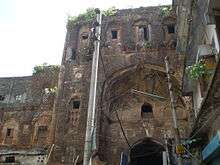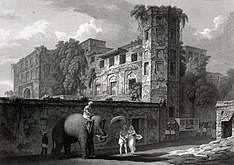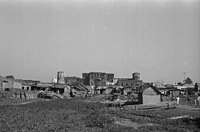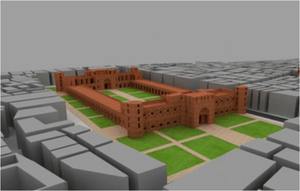Bara Katra
Bara Katra (Bengali: বড় কাটরা; Great Caravanserai), a historical and architectural monument, is one of the oldest buildings in Dhaka.[1] The word Katra may have originated from Arabic word Katara which means colonnaded building. 'Katra/ katara' in Arabic and Persian means 'Caravan (Karwan) Sarai' or simply a 'Sarai'. It is a palatial building dating to the reign of the Mughal dynasty in the Bengal region. It is situated to the south of Chowk Bazaar close to the north bank of the river Buriganga.
| বড় কাটরা | |
 Ruins of Bara Katra in 2008 | |
| Location | Dhaka |
|---|---|
| Type | Mughal building |
| Material | brick |
| Beginning date | 1644 |
| Completion date | 1646 |
History



Bara Katra was built between 1644 and 1646 AD by Mir Abul Qasim, the diwan (chief revenue official)[2] of Mughal prince Shah Shuja. It was intended to be Shah Shuja's residence, but Shah Shuja endowed it to Mir Abul Qasem.[3]
Less than half of the structure remains, and it is in disrepair. The Department of Archaeology has been unable to take charge of the monument owing to litigation and resistance from its owners. The owners have altered the original building and encroached upon it with new construction.[4]
— An inscription composed by Mughal poet Sa'ad-uddin Muhammad Shirazi
Architecture
The building follows the traditional pattern of Central Asian caravanserais and is embellished as per Mughal architecture. Originally it enclosed a quadrangular courtyard.[3]

The southern wing extends 67.97 metres (223.0 ft),[4] and fronted on the Buriganga River. In the middle is an entrance set in a three-storeyed projected bay.[3] The gateway has an arched alcove that rises to the second story, above which are the windows of the third storey.[4] The arched main entrance is in the centre of the alcove. The underside of the alcove, spandrels, and surrounding walls are decorated with plastered panels exhibiting a variety of forms, including four-centered, cusped, horseshoe, and flat arches. The main portion of the wing is two-storeyed and bookended by tall projected octagonal towers.[3]
The northern wing was similar, but with a less elaborate gate.[2] The east and west wings were single storey and about 70.10 metres (230.0 ft) long.[4] In the 19th century, Orientalist James Atkinson described the building as "a stupendous pile of grand and beautiful architecture".[5]
The southern entrance leads to a guardroom, then an octagonal domed hall (the ceiling of which is plastered and decorated with net-patters and foliage designs), and finally to the courtyard. On the ground floor of the southern wing, there are five vaulted rooms to either side of the gateway. On the upper floor, living chambers open off of a corridor.[4] Shops and living quarters surrounded the courtyard on all four sides.[2]
See also
- Choto Katra
- List of archaeological sites in Bangladesh
References
- "Bara Katra". Lonely Planet. Retrieved 25 September 2017.
- Asher, Catherine B. (1984). The Islamic Heritage of Bengal. Protection of the Cultural Heritage: Research Papers. Volume 1. Unesco. p. 55. ISBN 92-3-102174-5.
- Ahmed, Nazimuddin (1980). Islamic Heritage of Bangladesh. Dacca: Ministry of Information and Broadcasting, Government of the People's Republic of Bangladesh. pp. 50–51. OCLC 8476199.
- Begum, Ayesha (2012). "Bara Katra". In Islam, Sirajul; Jamal, Ahmed A. (eds.). Banglapedia: National Encyclopedia of Bangladesh (Second ed.). Asiatic Society of Bangladesh.
- "Bara Katra, south view, [Dhaka]". British Library. Retrieved 25 September 2017.
Further reading
- Hasan, Syed Mahmudul, Muslim Monuments of Bangladesh (Dhaka: Islamic Foundation, 1980)